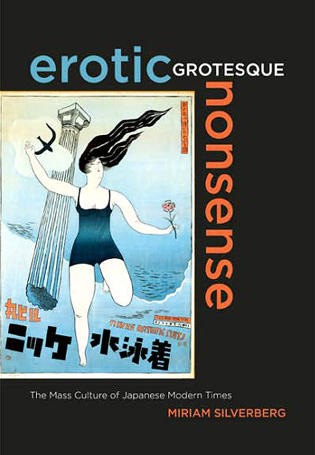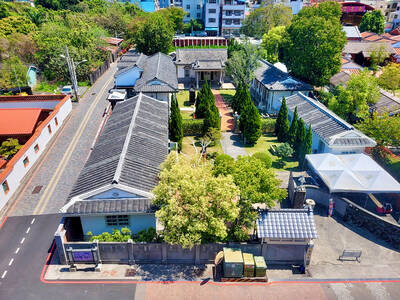This book is mildly interesting and here and there even enjoyable, though it's nothing like as exciting as its vivid title suggests it's going to be. It's about the entertainment and fashion industries in Japan in the 1920s and 1930s, and the title is the phrase the rising militarists concocted to describe and discredit such things. Men who are in favor of wars don't like people enjoying themselves. If your job is to persuade the young to pilot planes laden with explosives into ships belonging to people with different-colored passports, you can't let them think that a recipe for a good time is dancing the night away and sipping the newly-fashionable drinks called cocktails. You might be able to convince them that a spot of beheading in Nanjing would be more enjoyable, but when trying to promote that leisure activity you'd have to discourage them in advance from any alternative ideas they might have managed to acquire.
About eight years ago I attended a press conference in Taipei at which an arms expert said that any conflict between Taiwan and China would last a day and a half, that Taiwan would lose, and about 5 million Taiwanese people would be crushed to death as missiles sliced through buildings. He went on to express the opinion that today's young didn't appear to him to be very well prepared for this kind of eventuality.
This man sounded to me like one of those military Japanese in the 1930s. He didn't like seeing the young with tinted hair and studs in their tongues because he thought these things wouldn't predispose them to fight the good fight when the time came. War and happiness seem in all historical periods to be fundamentally opposed to each other, and it isn't difficult, when you're inviting people to have their faces torn away by pieces of flying metal, to understand why happiness is usually the preferred option.

In 1930s Japan, newspaper articles on fashion and new American films, plus gossip on sexual questions relating to movie stars, did sometimes serve to deflect attention from political and military developments. The Japanese invasion of Manchuria in 1931 was, according to this author, neglected in favor of an article on how sexual activity often moved from the cinema screen to the cinema seats. Thus popular culture, though frowned on by the increasingly militaristic authorities, could also be useful as a smokescreen to keep details of their own aggression from public scrutiny. And rather than print details of the League of Nations' Lytton Report on the invasion, the Tokyo press titillated its readers with a minute examination of the bodies of the performers in Hollywood's then-new Tarzan films, considered sensational at the time for showing a man in only a loincloth and a woman with bare legs. What was at one moment condemned as erotic, grotesque nonsense could at another be useful to hide inconvenient news.
Japanese life in the 20th century was characterized by extreme catastrophes alternating with an urgent love affair with all aspects of the modern. The two biggest catastrophes were the Great Earthquake of Sept. 1, 1923 and the bombing of Japanese cities in 1944 to 1945, culminating in the dropping of the atomic bombs on Hiroshima and Nagasaki. Most of Tokyo had to be re-built both times, but it was the earthquake that in the Japanese mind marked the big break with the traditional, making way for the arrival of the modern.
The term "modern" included department stores, provocative dress styles, smoking in public, cocktails, the financial independence (and perceived promiscuity) of women, photography, cinema, radio, mass-circulation newspapers and the influence of advertising, together with the arrival of a whole range of electronic household devices. Tradition, by contrast, was associated with social deference, religion, sexual modesty and hostility to Western innovations.
Erotic Grotesque Nonsense parallels Frank Dikotter's survey of the arrival of modern objects in early 20th century China in Things Modern [reviewed in the Taipei Times on Aug. 12, 2007]. Like him, Miriam Silverberg thinks of herself as "revisionist," meaning that she doesn't deplore the developments she describes as the incursions of an exploitative capitalism, but sees them as things welcomed by the population at large.
Hollywood films, in her view, were central to the Japanese idea of the modern during the 1930s. These, however, sometimes contained visions of the "exotic" Orient that included sexual invitation on the one hand and so-called Asiatic barbarism on the other. This was retained in doctored Japanese versions, but with Japan firmly installed on the "civilized" side, and the alluring, but nevertheless degenerate, habits reserved for the rest of Asia, notably China.
With the beginning of the Japanese invasions - first of China, then of Southeast Asia - erotic grotesque nonsense wasn't entirely sidelined, but was, at least initially, incorporated into the military's program. Comparisons were made between the female body and a battlefield - between male pleasure and male death, in other words. This clearly wasn't going to deceive many people for very long, and soon patriotic Japanese films openly glorified war and "self-sacrifice" for the greater good of the fatherland.
Erotic Grotesque Nonsense is an academic book, and so not easygoing for the general reader. This is a pity. A hundred years ago someone might have said that an Oxford professor called A.C. Bradley had written a wonderful book called Shakespearean Tragedy and that the average educated person might well enjoy it. Sadly, this is no longer the case, and "academic" now generally carries the implication "unlikely to give any real pleasure." Though this book generally avoids, for instance, post-structuralist jargon, its catchy title nonetheless remains its most alluring feature.

April 28 to May 4 During the Japanese colonial era, a city’s “first” high school typically served Japanese students, while Taiwanese attended the “second” high school. Only in Taichung was this reversed. That’s because when Taichung First High School opened its doors on May 1, 1915 to serve Taiwanese students who were previously barred from secondary education, it was the only high school in town. Former principal Hideo Azukisawa threatened to quit when the government in 1922 attempted to transfer the “first” designation to a new local high school for Japanese students, leading to this unusual situation. Prior to the Taichung First

Chinese Nationalist Party (KMT) Chairman Eric Chu (朱立倫) hatched a bold plan to charge forward and seize the initiative when he held a protest in front of the Taipei City Prosecutors’ Office. Though risky, because illegal, its success would help tackle at least six problems facing both himself and the KMT. What he did not see coming was Taipei Mayor Chiang Wan-an (將萬安) tripping him up out of the gate. In spite of Chu being the most consequential and successful KMT chairman since the early 2010s — arguably saving the party from financial ruin and restoring its electoral viability —

The Ministry of Education last month proposed a nationwide ban on mobile devices in schools, aiming to curb concerns over student phone addiction. Under the revised regulation, which will take effect in August, teachers and schools will be required to collect mobile devices — including phones, laptops and wearables devices — for safekeeping during school hours, unless they are being used for educational purposes. For Chang Fong-ching (張鳳琴), the ban will have a positive impact. “It’s a good move,” says the professor in the department of

Toward the outside edge of Taichung City, in Wufeng District (霧峰去), sits a sprawling collection of single-story buildings with tiled roofs belonging to the Wufeng Lin (霧峰林家) family, who rose to prominence through success in military, commercial, and artistic endeavors in the 19th century. Most of these buildings have brick walls and tiled roofs in the traditional reddish-brown color, but in the middle is one incongruous property with bright white walls and a black tiled roof: Yipu Garden (頤圃). Purists may scoff at the Japanese-style exterior and its radical departure from the Fujianese architectural style of the surrounding buildings. However, the property